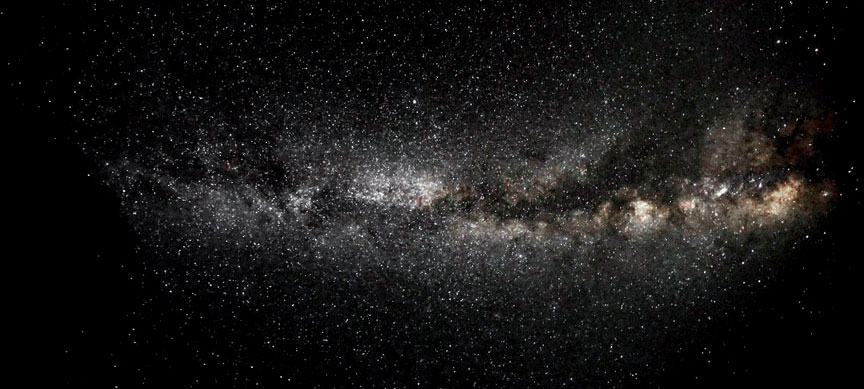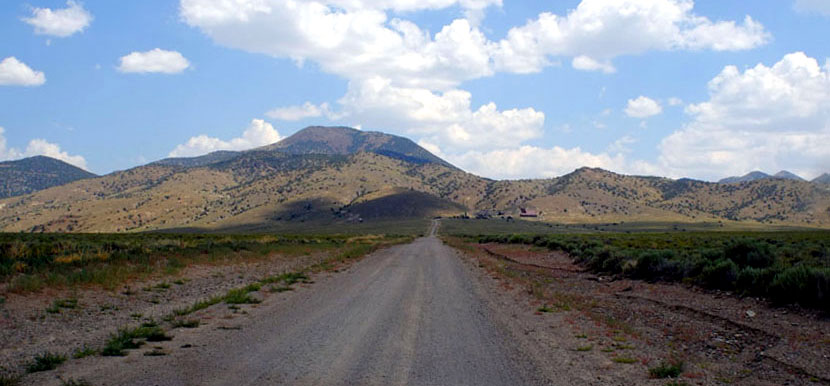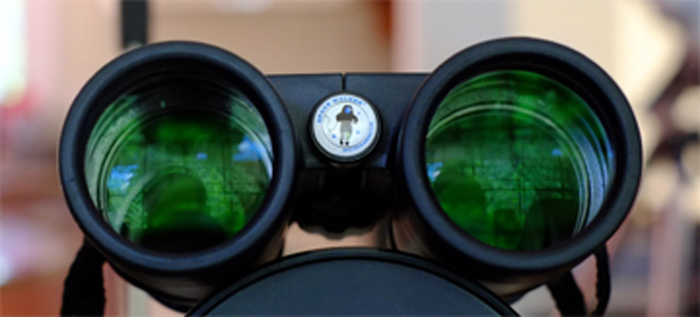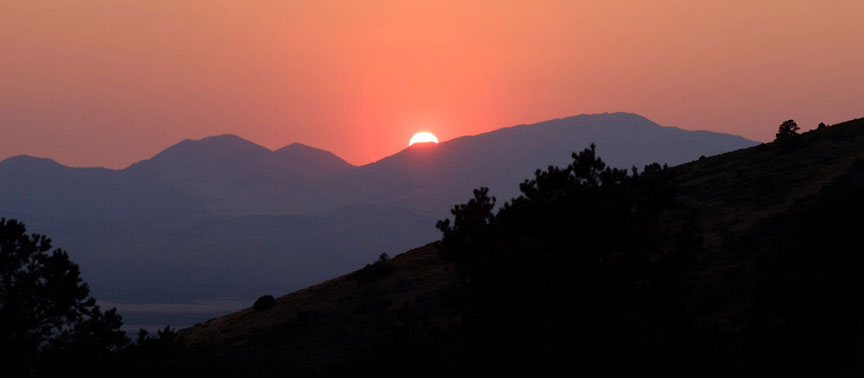The Dark Sky Experience
By: William A. PaoliniDiscuss this article in the forums
August 8, 2016More than four decades ago I happened upon dark skies quite by accident while on a cross country trip with my good friend Mike. The memory of that experience that has remained all these years is how the common Messier Objects and other DSO were all apparent with the naked eye, looking like bright fuzzy patches against the dark sky. Since then, my observing has primarily been only from suburban sites where the Milky Way is only rarely detectable.
Today, I like many others, wonder what it would be like to observe at a truly dark site. We also wonder about what equipment we should take, whether it would be a waste to take such a trip and not acquire and bring the largest aperture telescope possible, and of course we wonder just how different the celestial objects we observe will appear at these darker skies.
 Fig. 1 - 30 seconds time exposure of the Milky Way at the observing site.
Fig. 1 - 30 seconds time exposure of the Milky Way at the observing site.This year I was graciously invited to join the Off Fisher Lane Irregulars (OFLI) group of observers that is led by Jim Barnett in Petaluma, California. Their destination this year was a spot at an elevation of about 7,000' in the Berlin-Ichthyosaur State Park in central Nevada (Bortle 2-3, Bortle 2 after 11pm local IMO). While it excited me to have the opportunity to see the Milky Way in such detail and glory again, I was curious how my familiar suburban targets would appear at a very dark site, and when at such a site, how much advantage aperture provided for many of my familiar and showcase DSO.
 Fig. 2 - 30 Arriving at the entrance to the Berlin-Ichthyosaur State Park.
Fig. 2 - 30 Arriving at the entrance to the Berlin-Ichthyosaur State Park.Arriving at the site, the first impression for me, someone who is used to the lush and humid conditions of the U.S. East Coast, was how chokingly dry the air was, how fragile the trees and brush were in these conditions easily breaking like tinder even though green and alive, and how the air was filled with the taste of dust. Not exactly hospitable for an East Coast low-lander like myself, and very reminiscent of the time when I lived in the Arizona desert. Luckily though, the excellent skies, nice camping facilities, and company of the wonderful OFLI members more than overcame these environmental discomforts.
At the site, the OFLI members had a range of scopes in aperture from 90mm to 15 inches, including Apos, Maks, SCTs, and Dobs. For myself, I would mostly use a modest 90mm Apo and my binoculars, not wanting the hassle of a larger setup; and of course I could always catch views through the instruments of the other OFLI members if I so desired.
I had planned my observing quite meticulously prior to arriving, so I had a full complement of charts with targets selected and annotated ready to observe. But when I saw the sky that first night, with the Milky Way coursing brightly from horizon to horizon, I was too overcome with the sight and my observing plans succumbed to the glory of the dark sky night. So instead, I just absorbed the sky and let it take me where it would, which turned out to be a place I had not anticipated as this dark sky clearly demanded a completely different observing approach. Basically, there were just too many stars! Most constellations were hidden from view as they were overwhelmed by all the other stars within and around them. I actually could not even find the constellation Hercules as the region was just too densely filled with stars. Luckily Lyra stuck out though because of how bright Vega was, but even Cygnus just adjacent was difficult to acquire. Interestingly though, there was one constellation that was quite prominent, even more so than at a suburban site. Here under dark skies each of its stars seemed to shine with a character and brilliance beyond all others -- it was Ursa Major. I actually felt for the first time that Ursa Major very much had the character of being the gravitationally bound cluster that it is, centered about 75 light years from our solar system. So the dark site seemed to reveal that character about Ursa Major quite readily, and every time my gaze crossed its path it reminded me of this fact.
As my time under these spectacular skies progressed, it became apparent that using bright stars and constellations as markers to navigate the skies was somewhat inappropriate, and instead the Milky Way itself was the true navigation aid that I should be using. Its prominence was striking and the various knots of star clouds and black lanes of dust gave it a unique form and structure from end to end. Although I know of no work that presents the Milky Way as a roadmap to the sky, I could easily see that it was filled with such different form and structure as you traveled its length that these differences could easily serve as the signposts to navigate to various targets, only needing to hop onto the constellation asterisms when venturing further afield. So this is how I spent my evenings, driving from one end of the Milky Way at Sagittarius across the sky to the other horizon where Cassiopeia rested, using the knots and shapes of the Milky Way itself to re-learn where familiar targets laid in wait.
 Fig. 3 - Spacewalker 8x42 3D Binoculars.
Fig. 3 - Spacewalker 8x42 3D Binoculars.Now while I had the Stellarvue 90T Raptor Apo for my use, I found that the sight of this unfamiliar dark sky so strongly commanded by the Milky Way meant I had to step back some. So I abandoned the telescope for the second half of the first night and for the entirety of the second night and instead used only binoculars. Actually, I found nothing wanting in doing this as most familiar DSO were plainly visible naked eye and then nicely framed in the 8x magnification of the binoculars. It was only after becoming more familiar with this dense starscape before me that I felt comfortable moving back to a telescope again. This transition occurred for me on the third and last evening of the trip.
At first my observing was centered on familiar open star clusters. At such a dark site the little 90mm Apo was showing them much differently than even my larger scopes at my suburban site. It appeared that for open clusters, a darker site was a much greater advantage than was larger aperture at my suburban site. Moving to globular clusters however, this did not seem to be the case, and to my eyes they looked very much the same, aperture for aperture, as I was accustomed at my suburban site. Galaxies were yet another story. At my suburban site only a very few are even visible, mostly just the showcase ones show well like M31, M81 and M82, and the Leo Triplet, and those mostly needing my larger aperture scopes. Here at the dark site however, even the little 90mm was bringing in with beautiful clarity galaxies that were invisible for me back home. M51 and M101 as example were both actually quite easy to find and see with the little 90mm Apo showing their spiral structure readily, something that I have never seen at my suburban site. What was even more interesting, after seeing M51 and M101 in the little 90mm, was moving to the larger scopes used by other members and re-observing those same galaxies. To my astonishment, while the image scale was certainly larger using these bigger scopes, overall I felt that these galaxies were similarly rendered, with similar detail, contrast, and aesthetics. To my eyes the larger apertures did not really seem to be of great advantage compared to the humble little 90mm Apo for these objects. I would imagine that if I moved from the showcase galaxies to much fainter galaxies that the larger apertures would then have shown a clear advantage, but I am not a faint fuzzy hunter at heart so did not pursue any galaxies beyond the common ones which satisfied me quite sufficiently.
At the end of this dark sky experience, I can definitely say that I walked away with a new appreciation and understanding of the sky. I feel that a dark sky is a fundamentally different thing than the suburban sky, and as a result, they really need to be approached differently. It is no longer a field of disconnected asterisms called constellations but is instead a cohesive whole centered around the Milky Way. Under my suburban skies the constellations rule as the signposts to the heavens. Under dark skies, the constellations faded in comparison to the overwhelming enormity of the Milky Way with all its intricate form and structure. Seeing this large and complex structure also made me wonder more about dimensional positioning, what exactly each of the broad bright lanes was and where, and similarly what exactly each of the broad dark lanes was and where they were in this now very three dimensionally apparent stretch of galaxy overhead. It was also interesting to discover how not more aperture, but less aperture was perhaps more appropriate for dark site travel, at least for the beginning stages of the adventure. The overwhelmingly bright expanse of the Milky Way and the unbelievable density of stars making even common constellations unrecognizable indeed called me to even less aperture and wider fields than I am used to just to deal with the enormity of it all. If I do embark on another dark site trip some day, I know I will be very comfortable and will not feel under-gunned at all with just my trusty 4" Apo, my 12x50 Nikon AE binoculars, and the 8x42 Space Walker binoculars for three-dimensional exploration. So no bigger guns for me as there is just too much to appreciate and experience with these easier to travel and setup instruments.
Finally, some of the special sights that will remain memorable for me from this trip, for many years I am sure, were: how amazing the expanse of the Milky Way was being the most prominent sight to the naked eye, how so many deep sky objects were there to be seen with just the naked eye, how the Sagittarius region of the Milky Way was so bright that it looked more like a night light in the heavens filled with white puffs of clusters, how hours were not enough to explore the Milky Way's star clouds and clusters in the Sagittarius and Cygnus regions with the 8x42 Spacewalker 3D binoculars, how the clarity of M51 showed so brightly like a pair of opals in a jewelry setting through the Stellarvue 90mm Apo with a 14mm Morpheus eyepiece, how the pristine splits of delicate doubles like Delta Cygni and the subtle details on Mars were served up with authority by the Takahashi FC-100DL using a 5mm XO eyepiece, how the shear beauty and grandeur of both M31 and the Perseus Double Cluster were overflowing with stars through a Celestron C9.25 using a 40mm Titan-II ED wide field eyepiece, and finally how prominent the propeller blade structure in M13 was coming through a Celestron C9.25 Edge using a 27mm Panoptic eyepiece.
 Fig. 4 - Sunset from the Campsite.
Fig. 4 - Sunset from the Campsite.Have you ever wondered if a special trip to a truly dark site would be worth the time and effort? In my opinion, after this experience, the answer is a resounding yes! Further, the answer is doubly-yes if you can manage the trip with a fine group of comrades like the members of the Off Fisher Lane Irregulars turned out to be for me. So if your future holds the possibility of going to a truly dark site to observe, then I would highly recommend that you go with a group of friends and do not stress wondering if you will need more aperture than you currently have. My recommendation is to go with what you have or even less aperture, and to bring a pair of trusted binoculars as what awaits you can be so awe inspiring that it is best to acclimate to it with familiar aperture and potentially smaller aperture than you might normally use. And by all means, rather than trying to proceed along some prepared list of objects, just let go and be free and explore; let the Milky Way be your guide instead of any chart or program. And also take time to just lay back and look up at it all with your naked eyes. Doing this allows the grandeur to really set in, and with such dark skies you will be surprised at how many more meteors you will see.
My excursion with the Off Fisher Lane Irregulars to the Berlin-Ichthyosaur State Park in central Nevada provided a wealth of fond memories that I am sure will stay with me for many years. It was a great re-introduction to dark site observing, proved well worth the time and effort for the journey, and most importantly it served up an experience of the night sky that was truly fresh and exciting.
 About the Author
About the Author
William "Bill" Paolini has been actively involved in optics and amateur astronomy for 45 years, is author of the desk reference on astronomical eyepieces: Choosing and Using Astronomical Eyepieces which is part of the Patrick Moore Practical Astronomy Series published by Springer of New York, has published numerous product reviews on major online amateur astronomy boards, and volunteers with public tours at a famous vintage Clark refractor site.
Bill's professional background is as an officer in the U.S. Air Force and as a computer scientist, holding a Bachelor's degree in Computer Science and a Master of Science in Education. He has worked for the U.S. Department of Defense, the U.S. Department of Commerce, the Federal Trade Commission, the Federal Reserve, the World Bank, and a variety of commercial corporations in the information technology, information technology security, and telecommunications industries.
Bill has been observing as an amateur astronomer since the mid-1960's, grinding mirrors for homemade Newtonian telescopes during the 1970's and eventually owning, using, and testing several hundreds of eyepieces in a wide variety of telescopes from Achromatic and Apochromat refractors to Newtonian, Maksutov-Cassegrain, and Schmidt-Cassegrain designs. Today he enjoys observing and testing new equipment from his suburban home west of Washington, D.C., where his primary amateur astronomy pursuits are lunar, planetary, bright nebula, open cluster, and globular cluster observing.
Click here for a formatted PDF version of this article.***
This article is placed in the public domain with no restrictions when made available in its entirety.
All images Copyright 2016 by William Paolini and require written permission if used apart from this article.
For a formatted PDF version of this article, please contact the author at wapaolini@hotmail.com
Dismiss Notice
New Cookie Policy
On May 24, 2018, we published revised versions of our Terms and Rules and Cookie Policy. Your use of AstronomyConnect.com’s services is subject to these revised terms.

